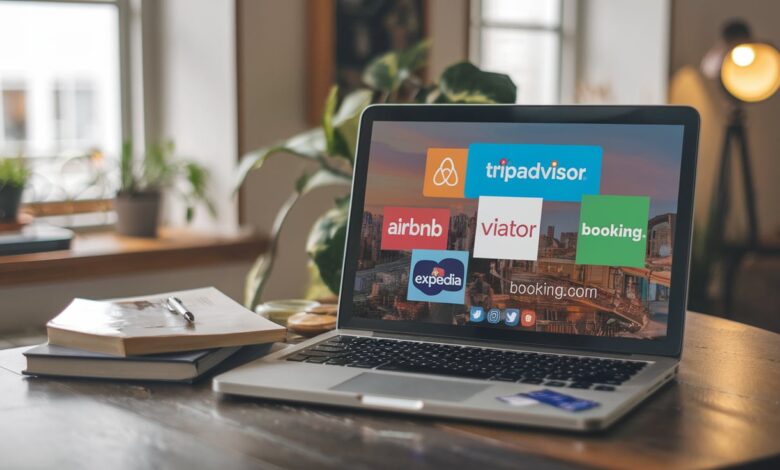Top 5 Online Platforms to Make Money from Travel

In today’s digital age, the tourism industry has transformed, offering countless opportunities to make money online. Whether you’re a travel enthusiast, a local guide, or a property owner, there are numerous platforms that can help you monetize your passion for travel. But with so many options, where should you begin? How can you stand out in a crowded marketplace and turn your knowledge or property into a reliable income stream?
From renting out your home to selling unique local experiences, platforms like Airbnb and Viator provide powerful tools for anyone looking to tap into the tourism market. Are you a seasoned guide or someone with a passion for teaching others? GetYourGuide and platforms like Udemy offer a space to showcase your expertise through tours or online courses, helping you reach global audiences and earn passive income. And let’s not forget about the immense potential of Instagram and YouTube—two social media giants that allow you to build a brand, share your travels, and make money along the way.
In this post, we’ll explore five of the top online platforms that can help you profit from tourism. Whether you’re looking to rent out a property, teach a course, or create unforgettable travel experiences, there’s a platform that fits your goals. Ready to turn your passion for tourism into a thriving business? Let’s dive in and discover the best opportunities for you!
II. Platform 1: Airbnb – Rent Out Your Property or Experience
Airbnb isn’t just for travelers anymore—it’s a powerhouse for anyone wanting to earn money by sharing their home or offering unique local experiences. Whether you’re looking to rent out a spare room or offer a guided city tour, Airbnb allows you to monetize your property or skills with ease. But what makes Airbnb so appealing for tourism entrepreneurs?
Why Choose Airbnb? Airbnb is a globally recognized brand, with millions of users seeking unique stays and experiences. If you have an extra space or even a one-of-a-kind local activity to offer, this platform provides an ideal opportunity to connect with travelers from all over the world. But the real question is—how can you stand out?
How to List Your Property for Rent Setting up your listing is straightforward. With a well-crafted description and high-quality photos, you can showcase your property or space to attract travelers. But remember, the key is to offer something more than just a place to sleep. Travelers today are looking for authentic experiences, so think about what makes your property or neighborhood special. Do you have a great view, proximity to tourist spots, or an interesting historical story to tell? Highlight these features to captivate potential guests.
Creating Unique Experiences for Tourists Airbnb’s “Experiences” feature allows hosts to offer tours, activities, and unique experiences that go beyond the typical vacation itinerary. Whether it’s a cooking class, a city bike tour, or an art gallery walk, experiences are a great way to connect with tourists on a deeper level. If you have specialized knowledge or a passion you want to share, Airbnb offers the perfect platform to showcase it. Not only can this generate income, but it also helps build lasting relationships with your guests.
Maximizing Earnings with Seasonal Pricing Airbnb allows you to adjust your pricing based on demand, so make sure to take advantage of peak tourist seasons. Whether you’re located in a tropical paradise or a bustling city, adapting your rates to seasonal trends can help maximize your earnings.
Tips for Successful Airbnb Hosting To succeed as an Airbnb host, focus on providing excellent guest experiences. Always respond promptly to inquiries, keep the space clean and well-maintained, and create a warm, welcoming environment. A few thoughtful touches, like providing local maps or offering a homemade breakfast, can turn a good experience into a great one. And, of course, positive reviews go a long way in attracting future bookings.
III. Platform 2: Viator – Sell Tours and Activities to a Global Audience
Are you a local tour guide or a tourism professional who loves showing people the best of your city or region? Viator offers an incredible opportunity to turn your knowledge into profit. It’s an online marketplace where travelers can book tours, activities, and experiences—all organized by local experts like you. So, how can you use Viator to bring your tourism business to the world?
Introduction to Viator and Its Reach Viator is part of the TripAdvisor family, meaning it has a huge customer base actively searching for things to do on their travels. Whether you specialize in walking tours, cooking classes, or adventure activities, this platform gives you access to a global audience ready to explore. Viator’s marketplace is vast, so if you’re offering something unique or niche, it can be a great way to attract the right kind of tourists.
Setting Up Your Tour or Activity Listing Creating a listing on Viator is simple, but what’s crucial is creating an enticing description that stands out. Think about the experience you’re offering and focus on the unique aspects that will appeal to travelers. Make sure to include high-quality images, detailed itineraries, and clear pricing. Viator provides a robust platform to manage bookings, track your earnings, and communicate with guests, making it easier than ever to manage your tours.
Pricing Strategies for Tour Guides and Operators When it comes to pricing, consider the competitive landscape. Viator offers dynamic pricing, which means you can adjust prices based on demand or seasonality. To remain competitive, ensure your prices reflect the value you’re offering but are still attractive to tourists. Offering discounts for group bookings or last-minute deals can also help attract more customers.
Building Your Reputation through Reviews Much like Airbnb, reviews play a major role in your success on Viator. Encourage your guests to leave positive feedback after their tours. The more glowing reviews you get, the more likely potential tourists are to book your experiences. Over time, your reputation as a trusted and knowledgeable guide will grow, leading to more bookings and greater earnings.
Promotional Tools for Attracting Tourists Viator offers various promotional tools to help your tour stand out. From paid ads to seasonal deals, utilizing these resources can increase visibility and drive more bookings. Think about what makes your activity unique, and use Viator’s marketing tools to highlight these selling points.
IV. Platform 3: GetYourGuide – Reach Global Tourists with Custom Offers
GetYourGuide is another powerful platform for tourism entrepreneurs, offering a unique way to sell tours, experiences, and activities. Like Viator, GetYourGuide connects you with tourists from around the world, but what sets it apart is its focus on curating high-quality, customer-oriented experiences. How can you leverage GetYourGuide to grow your tourism business?
What Makes GetYourGuide Stand Out? With a strong global presence and a user-friendly platform, GetYourGuide helps you reach tourists looking for personalized and memorable experiences. Whether you’re offering guided hikes, wine tours, or cooking workshops, GetYourGuide provides a seamless way to showcase your offerings to a wider audience.
Listing Activities, Tours, and Local Experiences To get started, simply list your experiences on the platform and make sure your descriptions are engaging and clear. The key is to offer unique activities that people can’t find on traditional travel itineraries. Highlight the authentic experiences you’re offering and focus on what makes your tours special.
Leveraging Flexible Pricing and Discounts GetYourGuide offers flexible pricing options that allow you to adjust according to demand, time of year, or the type of customer. Offering discounts during off-peak seasons or bundling activities together can help increase your chances of making sales. The ability to set different price points for group bookings or private tours can also help cater to different customer segments.
Building Partnerships for Broader Exposure If you’re a small business owner or a local tour operator, consider forming partnerships with other tourism professionals to cross-promote each other’s offerings on GetYourGuide. By collaborating with others, you can expand your audience and create a wider range of activities for tourists to choose from.
Optimizing Your Profile for Visibility Your profile is your online storefront, so make it appealing! Use high-quality photos, engaging descriptions, and highlight what makes your offerings special. The more comprehensive and detailed your profile, the better your chances of standing out to potential customers.
These platforms are just the beginning of the many ways you can leverage online tools to make money from tourism. Stay tuned for the next section, where we’ll explore how teaching courses on platforms like Udemy can help you reach a broader audience and create a steady stream of passive income!
V. Platform 4: Udemy or Skillshare – Teach Tourism-Related Courses
If you’re an expert in a specific area of tourism—whether it’s travel photography, local culture, or even language instruction—creating an online course can be a lucrative way to share your knowledge while earning money. Platforms like Udemy and Skillshare offer incredible opportunities for you to design, market, and sell courses to an ever-growing global audience. But what’s the best way to turn your tourism expertise into an online course that sells?
Why Create an Online Course for Tourists and Travel Enthusiasts?
The rise of online learning has created a booming market for education, and tourism is no exception. Travel enthusiasts are constantly looking for ways to improve their skills, whether it’s learning how to take better vacation photos, exploring local cuisines, or diving deeper into the cultural history of destinations they visit. If you have specialized knowledge, creating a course can be an ideal way to monetize your expertise. Plus, you get to build a passive income stream—earning money from your course long after it’s created!
Topics to Consider: Travel Photography, Languages, Culture
When it comes to course creation, think about what’s in demand. Here are a few course ideas that align well with the tourism market:
- Travel Photography: Teach people how to take stunning vacation photos, from capturing landscapes to taking great portraits.
- Languages for Travelers: Offer courses in essential phrases or language basics that will help tourists feel confident in a new country.
- Cultural Awareness: Share tips on how to navigate local customs, traditions, or etiquette to make tourists feel more at ease in unfamiliar places.
You don’t need to be a certified expert to teach something you love, but make sure you have enough experience to provide real value. Tailor your courses to people who want to enhance their travel experiences.
Steps to Design and Publish a Course
Both Udemy and Skillshare provide step-by-step guidance for creating and publishing your course. Start by outlining your course structure—what lessons will you include, and how will you present them? You can use video lectures, quizzes, reading materials, and downloadable resources to make the course engaging. Keep your content clear, concise, and easily digestible for your students.
- Set a Course Goal: What do you want your students to achieve by the end of your course? This will guide the content creation process.
- Create Engaging Content: Use high-quality visuals, real-life examples, and interactive elements like quizzes to keep students engaged.
- Publish Your Course: Once your course is ready, it’s time to upload it to Udemy or Skillshare. Both platforms have tools that help you reach potential students through built-in search functions and algorithm-driven recommendations.
Marketing Your Course to a Global Audience
With millions of users already browsing Udemy and Skillshare, how do you ensure your course stands out? Start by creating an appealing course description and an engaging promotional video that highlights the benefits of taking your course. You’ll also want to engage with your students through course updates, Q&A sections, and personalized feedback. The more interactive you are, the more likely students are to recommend your course to others.
- Social Media Promotion: Share your course on social media platforms like Instagram, YouTube, and Facebook. Posting snippets or behind-the-scenes content about the course will spark interest.
- Leverage Reviews: Positive reviews are crucial to building credibility. Encourage your students to leave feedback, and respond to their comments to create a stronger relationship.
Building Passive Income through Educational Content
One of the best things about creating a course on Udemy or Skillshare is the ability to earn passive income. Once your course is live, students can enroll at any time, and you’ll continue to earn money. Additionally, these platforms often run promotions or offer discounts to attract new students, helping you reach a broader audience and increase your revenue.
Creating an online course is an investment in both time and energy, but it can pay off long-term. With tourism-related courses, you can establish yourself as an authority in your field while helping travelers improve their experiences and make the most out of their trips.
VI. Platform 5: Instagram & YouTube – Build a Brand Around Tourism Content
In today’s digital-first world, social media platforms like Instagram and YouTube have become powerful tools for building a brand, connecting with a global audience, and generating income. If you’re passionate about tourism and travel, these platforms offer the perfect opportunity to showcase your adventures, share insider tips, and monetize your content. But how can you turn your social media presence into a reliable revenue stream?
Using Social Media to Promote Travel Destinations and Services
Instagram and YouTube are visual platforms that thrive on captivating content. Whether you’re showcasing hidden gems, sharing cultural insights, or creating engaging travel vlogs, both platforms allow you to inspire and educate your audience. By posting high-quality content regularly and using the right hashtags, you can grow your following and attract an audience that values your perspective.
- Instagram: Share stunning photos, Reels, and Stories that highlight the beauty and uniqueness of destinations. Your audience will follow you for the travel inspiration, and brands will want to partner with you for sponsored posts.
- YouTube: Vlogs, destination guides, and travel tips can attract viewers who are looking for in-depth information. With YouTube’s long-form video format, you can provide a richer experience for your audience.
Monetizing Travel Content Through Sponsorships
Once you’ve built a strong following on Instagram or YouTube, brands within the tourism industry may reach out to collaborate. Tourism boards, hotels, airlines, or travel gear companies are always looking for influencers to promote their products or services. By partnering with these brands, you can earn money through sponsored content or affiliate links.
- Sponsored Posts: Brands may pay you to create content that features their products or services. The key is to ensure that the brands align with your values and audience interests.
- Affiliate Marketing: Many travel companies offer affiliate programs where you earn a commission for every product purchased through your unique referral link. Popular affiliate partners in the tourism space include booking platforms, travel gear companies, and experiences providers.
Growing a Loyal Follower Base
To succeed on Instagram and YouTube, it’s essential to build a community around your content. Engage with your followers by responding to comments, asking questions, and encouraging them to share their own travel experiences. The more you interact, the more likely your followers will become loyal fans who eagerly await your next post or video.
- Consistency: Posting regularly is key to keeping your audience engaged. Whether it’s daily Instagram stories or weekly YouTube videos, maintaining a consistent schedule helps grow your following.
- Authenticity: Be yourself. Audiences on both Instagram and YouTube are drawn to authenticity. Share your true experiences and insights, and be transparent with your audience.
Turning Your Social Media into a Revenue Stream
With a strong following and an engaged community, Instagram and YouTube can be lucrative. But it’s important to diversify your income streams. Consider offering travel-related products, launching a Patreon for exclusive content, or selling your own travel guides or merchandise. Diversifying allows you to earn from multiple sources, ensuring you have a sustainable income.
Building a social media brand around tourism is one of the most flexible and scalable ways to make money online. With dedication, creativity, and the right strategy, you can turn your passion for travel into a thriving business.
These platforms have revolutionized how we think about earning money from tourism. Whether you’re renting out a property, selling tours, teaching online, or building a social media presence, there’s a way to turn your passion into profit. Ready to get started? The world of online tourism entrepreneurship is waiting for you.
VII. Bonus: Tips for Maximizing Revenue Across Multiple Platforms
If you’re serious about turning your tourism passion into a profitable online business, one of the best strategies is to diversify your income streams. While focusing on a single platform can bring success, leveraging multiple platforms can significantly boost your revenue and provide financial security. But how do you manage it all and ensure each platform works together harmoniously?
Here are some expert tips to help you maximize your revenue while balancing multiple tourism-related platforms:
1. Diversifying Your Income Streams
The key to long-term success is diversification. Instead of relying on just one platform, why not use multiple sources of income? Here’s how you can do it:
- Renting out properties on Airbnb while offering local tours on Viator or GetYourGuide.
- Creating an online course on Udemy about tourism photography or cultural awareness, while simultaneously running a travel-focused YouTube channel.
- Building your social media presence on Instagram or YouTube while also promoting your Airbnb listing or local tours.
This approach provides you with a cushion, as income from one platform can help make up for slow periods on another. For example, if you’re having a slow season for tours, your online course sales or social media sponsorships could fill the gap.
2. Effective Time Management and Automation Tools
Managing multiple platforms can feel overwhelming, but it doesn’t have to be. With the right time management and automation tools, you can stay organized and ensure you’re maximizing your efforts without burning out.
Here are a few tools that can help:
- Scheduling Tools: Platforms like Buffer, Hootsuite, and Later allow you to schedule your Instagram posts, YouTube videos, or even blog content in advance. This way, you can keep your content flowing without having to post in real-time every day.
- Automation for Email Marketing: Services like Mailchimp or ConvertKit can automate your email campaigns, whether you’re promoting new tours, special offers, or updates about your online courses. Set up an email sequence to nurture your subscribers and encourage them to book your services.
- Task Management: Use tools like Trello, Asana, or Notion to organize tasks across different platforms. Whether you’re planning a new course launch, brainstorming content for YouTube, or coordinating your Airbnb calendar, having a centralized task management system keeps everything in check.
With a bit of upfront planning, you’ll be able to stay on top of your multiple platforms without feeling scattered or overwhelmed.
3. Engaging with Your Audience for Long-Term Growth
Your audience is the backbone of your online tourism business. Whether they’re staying at your Airbnb property, booking a tour, or learning from your online course, building a relationship with your audience is key to long-term growth. Engaging with them helps create loyalty, encourage repeat business, and increase your reach.
Here’s how you can do it:
- Respond to Comments: Always take the time to reply to comments on your social media, YouTube videos, or course discussions. Engagement boosts your visibility and shows your audience you care about their feedback.
- Host Q&A Sessions or Live Streams: Going live on Instagram or YouTube is a great way to interact in real time with your followers. You can answer questions about your tours, provide travel tips, or even showcase a behind-the-scenes look at your life as a tourism entrepreneur.
- Share User-Generated Content: When your customers share their experiences, whether it’s a post about their stay at your Airbnb or a review of a tour, re-share it to your social media. Not only does it give you valuable social proof, but it also strengthens the relationship with your followers.
By nurturing these connections, you can create a loyal customer base that keeps coming back for more.
4. Tracking Performance and Adjusting Strategies
To make the most out of your online tourism business, it’s crucial to track performance and continuously adjust your strategies. Without data, you can’t know what’s working and what needs improvement. Thankfully, all the platforms we’ve discussed—whether it’s Airbnb, Viator, Udemy, or social media—offer valuable insights that can guide your decisions.
Here’s how you can use performance tracking:
- Monitor Sales and Traffic: Use tools like Google Analytics or the built-in analytics in platforms like YouTube and Instagram to track how your content and offers are performing. Are your posts getting the engagement you want? Are your course enrollments growing steadily?
- Customer Feedback: Pay close attention to reviews and feedback on platforms like Airbnb, Viator, or Udemy. What do people love about your offerings? Are there any common issues or suggestions? This feedback is invaluable for improving your offerings and increasing customer satisfaction.
- A/B Testing: Try testing different pricing strategies, course formats, or promotional methods. For example, on Udemy, experiment with different course prices or discounts, and see how it affects your sales. On social media, test out different types of content—such as video versus photo posts—and analyze which works best.
Regularly reviewing your performance data and making informed adjustments will help you stay competitive and continue growing your business.
5. Leveraging Partnerships for Broader Exposure
One of the fastest ways to grow your online tourism business is through partnerships. Whether it’s collaborating with local tourism boards, influencers, or other small businesses, working with others can help expand your reach and build your brand.
Here are some partnership ideas:
- Collaborate with Influencers: If you have an online course or a unique local tour to offer, partner with social media influencers or travel bloggers to get the word out. A well-placed shoutout can bring in a wave of new customers.
- Form Local Partnerships: If you’re offering local experiences, team up with nearby restaurants, hotels, or transportation services to cross-promote each other. This can help you reach tourists who are already in your area.
- Co-Create Content: On platforms like YouTube or Instagram, collaborate with fellow travel creators. Joint videos, interviews, or guest appearances can help you tap into their audience and build a larger following.
Strategic partnerships can open up new opportunities and help you establish your business as a well-rounded tourism offering.
As we’ve explored, there are countless opportunities to turn your passion for tourism into a profitable online business. From listing your vacation property on Airbnb to offering unique travel experiences on Viator, creating engaging online courses, or building a loyal social media following—each platform offers a different path to success. But it’s not just about choosing a platform. It’s about strategically combining these avenues to create a well-rounded business that works for you, your audience, and your bottom line.
Think about it: what would it be like to wake up every day knowing that your knowledge, creativity, and passion for travel are driving a sustainable income? Whether you’re teaching tourists to take stunning photos, sharing your favorite destinations on YouTube, or offering local tours that highlight your area’s hidden gems, the possibilities are limitless.
The real power lies in diversifying your efforts. By strategically managing multiple platforms—whether it’s running an Airbnb business, teaching on Udemy, or posting daily travel tips on Instagram—you can create multiple income streams that will help buffer against any slow periods and keep you thriving. Not only will this increase your earning potential, but it will also allow you to reach a wider audience and establish yourself as a go-to authority in the tourism industry.
So, what’s your next step? Are you ready to embrace the digital opportunities that tourism offers? There’s no time like the present to begin building your online tourism business and exploring how these platforms can fit together to support your entrepreneurial journey.
Remember, success in the online tourism space doesn’t happen overnight. But with consistency, strategic planning, and the willingness to adapt, you can turn your passion into a thriving business. So, which platform will you start with? The world is waiting for your unique tourism offerings—and so is your future self!







